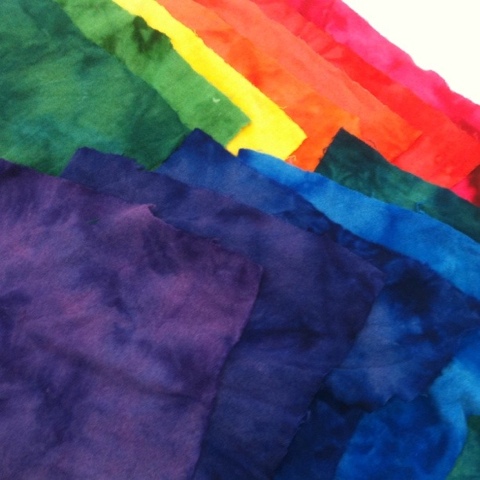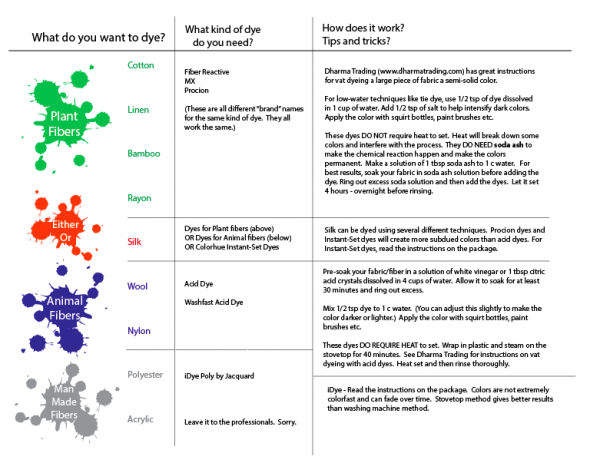 Another conversation, another blog post. This week the topic of conversation has been all about dyeing. We have been gearing up for summer camp at work and we do a lot of dye projects. We have a dye lab and so it makes it very easy for us to do really great dyeing. I have discovered that there is a LOT of mis-information about how and what to dye, so I thought it might be helpful to post some information in the hopes that someone might Google this someday and get some help. I have been the supervisor of the dye lab for about 8 years now, so I have seen a lot of techniques. I am not going to say that any of these things I am suggesting are the right way to do this (there is no one right way), but these are the things I have learned that should improve your chances of success.
Another conversation, another blog post. This week the topic of conversation has been all about dyeing. We have been gearing up for summer camp at work and we do a lot of dye projects. We have a dye lab and so it makes it very easy for us to do really great dyeing. I have discovered that there is a LOT of mis-information about how and what to dye, so I thought it might be helpful to post some information in the hopes that someone might Google this someday and get some help. I have been the supervisor of the dye lab for about 8 years now, so I have seen a lot of techniques. I am not going to say that any of these things I am suggesting are the right way to do this (there is no one right way), but these are the things I have learned that should improve your chances of success.
What’s your fiber?
So there are lots of kinds of dye and each one of them is great with a certain kind of fabric. So the first thing to do is to figure out what fabric you are working with. Read the tag, check the label. You can even do a burn test if you are totally stumped. If you have a blend that is at least 80% something, you should follow the instructions for the predominant fiber. For instance, we dye 80% wool/20% rayon felt (using the instructions for dyeing wool) and get a nice heathered kind of appearance because the wool takes the dye and the rayon doesn’t.
(Click to download a .pdf of my Dye Chart and to be able to see it larger.) Once you have figured out what fiber you have, then you can find out what kind of dye you need to use. I have given you very very simple instructions for each dye. Check out Dharma Trading’s website for really great how to’s for working with all of the different dyes. They are a great source for ordering both dyes and dyeable fabrics too.
In a nutshell
The reason dyes work is that there is a chemical reaction going on between the fiber and the dye solution. Molecules of the fiber react with molecules of the dye to make a (hopefully) permanent chemical bond. If you get the chemistry right, you will have great colorfast dyed fabrics that don’t bleed and fade. If not, you might have purple ninjas. But more about that later.
Just in summary…
Cotton & plant fibers • Procion/Fiber Reactive/MX dye • needs soda ash • NO heat
Wool & animal fibers • Acid dye • Needs vinegar/citric acid • Needs heat
Polyester • iDye Poly • Needs heat
Silk • Dye like plant fibers or animal fibers with slightly different results
A few interesting facts. Nylon behaves like animal fibers when it comes to dye. You can make really cute tights and camisole dresses by dyeing thrift store finds that are nylon fabrics. Koolaid works great to dye wool because it contains two key components: dyes and citric acid. You can’t dye acrylic. They just don’t make consumer dyes that can do it. There is also one more class of dyes called “sublimation dyes”, which work on most man-made fibers and are activated by vaporizing the dye under high heat. That is what is in Crayola Fabric Crayons. But the process is SO different for these, I am just leaving it at that. I am also not going to go in to natural dyes. Totally amazing and cool, but the chemistry for those is a whole other art form.
Purple Ninjas?
You will notice that RIT dye is nowhere on any of my lists. Why? RIT is a Frankenstein Dye. Because they want to make it work with anything you throw at it and so they can say it dyes anything, they mix together all kinds of dyes in one little packet. In the mixture there is bound to be the right molecule to bind with whatever fiber is dropped in the dye bath. The problem is that in trying to do everything, it really does nothing very well at all. All of those extra chemicals just get in each others way and the heat/salt/acid that one reaction needs, makes some other ones not work so well. So the overall result is everything works a little and nothing works very well. A good friend emailed me just before Halloween a few years ago with an example of just this effect. While trying to make a ninja costume in proper ninja black, she got something more like yucky faded purple. Black is a hard color to dye even if you are using exactly the right chemistry; throw in some Frankenstein and you get nothing close to black at all.


